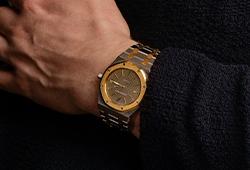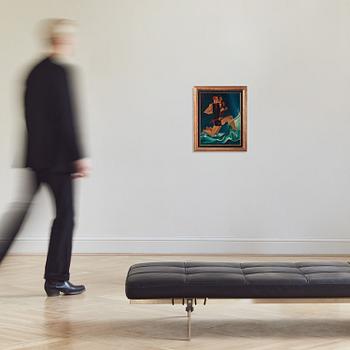Gösta Adrian-Nilsson
"Badande (Sommarkväll)"
Signed GAN and dated -26. Canvas, 49 x 38 cm.
Provenance
PhD Runnqvist
Bukowski Auktioner, Höstens Moderna Auktion 557, Stockholm, 2010, cat. no. 131.
Exhibitions
Liljevalchs konsthall, Stockholm, "Gan 1884-1965, 100 år", 6 April-20 May 1984, cat. no. 234.
Malmö Konsthall, "Gan 1884-1965, 100 år", 29 June-26 Aug 1984, cat. no. 234.
Literature
"På stan", April 6, 1984, newspaper article about Liljevalchs konsthalls exhibition "Gan 1884-1965", illustrated in colour.
More information
The 1924 Olympic Games in Paris inspired Gösta Adrian-Nilsson (GAN) to create one of his larges works during his Paris years 1920-1925, the painting “Olympiad” (“The Javelin Thrower”), which sixty years later had the honor of adorning both exhibition poster and catalogue for GAN’s 100 year anniversary exhibition at Liljevalchs and Malmö Konsthall (the painting belongs to Kulturen in Lund). After his return to Lund in 1925, sports motifs reappear from time to time in his paintings, for e.g. in “The Football Player” (1926) and in the dynamic boxing painting “Knockout” (1927) as well as in later paintings such as “Cross-country Skier”(1935), “Rugby” (1935) and “Hockey Goalkeeper” (1942).
The origins of GAN's fascination with sportsmen and athletes goes back to his time in Berlin in 1913-14 and beyond. In the catalogue for the GAN exhibition at Mjellby Konstmuseum in Halmstad 2002, Jan Torsten Ahlstrand writes: “After moving back home to Lund in August 1914, GAN rented a room by Idrottsgatan at Väster, close to the sports fields, where he could conduct studies of muscular young men in movement. He was inspired to paint near-futuristic depictions of athletes, a high jumper, a shot putter and some football players [...] GAN was particularly attracted to the rough and combative sports such as football, boxing and rugby, seeing in them a symbol of the struggle for existence. Among his literary favorites was Jack London, whose Social Darwinist and Nietzschean-tinged novels had made a strong impression on him.”
GAN's interest in sports was multi-faceted. A hundred years ago, sport was a new and vital social phenomenon, which became part of emerging modern society. GAN, with his alert interest in what was current, became one of the first artists in Europe to paint sportsmen in a Modernist style. But for GAN sport became more than a symbol of modernity: the studies and paintings of athletic sportsmen also reveal a hidden homoerotic interest. Athletics and most other sports at this time were still a purely masculine affair and GAN had a strong attraction to athletic young men.
The painting “Bathing (Summer night)” is an excellent example of GAN's sports pictures after the mid-1920s with the two muscular men, who are running out into the foaming ocean waves. The fragmentary Cubist and movement-filled Futuristic shapes from the sports images from the 1910s are now transformed into whole figures that have been “frozen” in the moment of maximal movement. Thus the movement acquires a permanent, lasting character, which expresses the very idea of movement more strongly than a momentary depiction. The painting also shows how GAN clings to certain motifs, in this case sports, but in a constant effort to move forward and renew it.
The last word is given, however, to GAN's friend and fellow artist Erik Olson who wrote the following in a letter to his brother Axel on July 20, 1930: "I must say, and this with joy, that there are real gems in Gösta's production - especially the sports paintings and folk songs. 1924 - 1927 is a good era of Gösta".
Artist
Gösta Adrian-Nilsson is most notable as a visual artist, and he is a pioneer of Swedish modernism. He studied at the Tekniske Selskabs Skole in Copenhagen and later for Johan Rohde at Zahrtmann’s school in Copenhagen. As an avant-gardist, Nilsson was constantly searching for new influences. In Berlin, he was influenced by the circle around the radical magazine Der Sturm, through Kandinsky and och Franz Marc. In Paris through Fernand Legér and the artists in his circle. GAN was an eclectic in the positive sense of the word. He took the the artist styles of the 1900s and created new impressions. Symbolism, cubism, futurism, expressionism, constructivim and Theosophy were the colours occupying his internal pallet. He had a sharp eye for the masculine and his painting was often energized by the vitality of modern technology, vibrant eroticism, and echoes of tyrants. No other Swedish modern artist exhibits such a unique style.
Read more































































